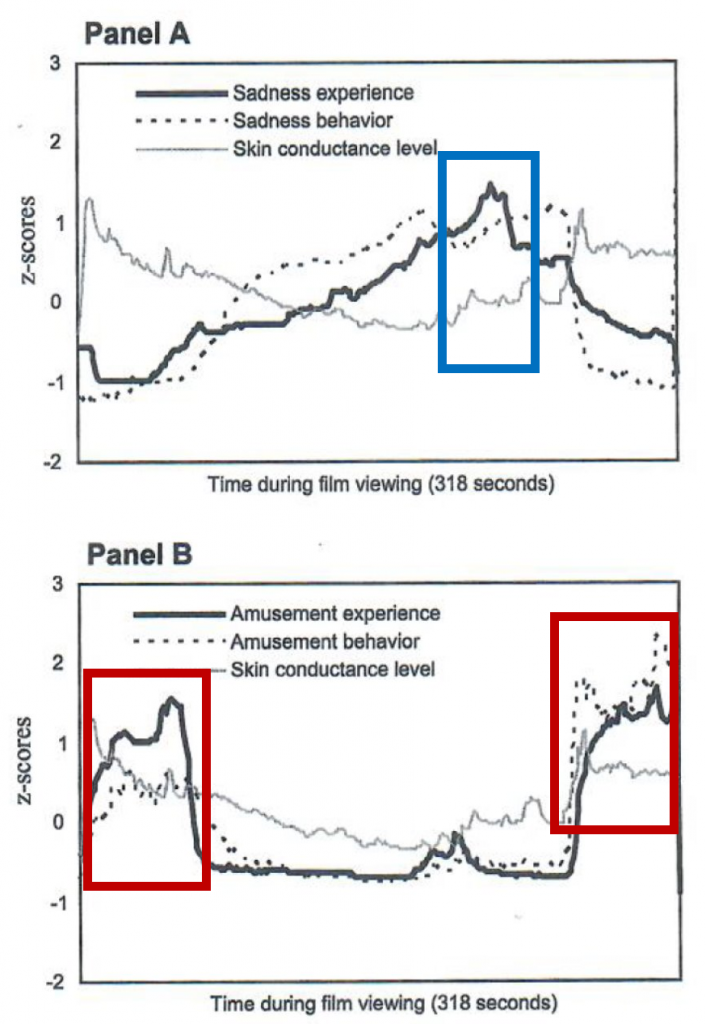Chapter 6: Measuring and Manipulating Emotions
Emotion Coherence
The last part of the chapter focuses on emotion coherence. Emotion coherence is measured as an emotional experience occurs over a period of time. Emotional coherence occurs when changes in emotion components occur at the same time. For instance, coherence would occur if someone saw blood and showed a disgust expression, experienced an increase in arousal, and made an external cognitive appraisal all at the same time. Researchers want emotion coherence to occur in their studies, because coherence provides further evidence that someone is truly experiencing the emotion being manipulated.
A classic study by Bonanno and Keltner (2004) investigated several types of emotion coherence. These three types of coherence are displayed in Table 3. Note that event-response coherence is an example of between-system coherence.
Table 3
Definitions and Examples of Types of Emotion Coherence
| Type of Coherence | Definition | Example with Disgust |
|---|---|---|
| Within-system coherence | coherence within the same emotion component | AU 9 (nose wrinkle), AU 15 (lip corner depressor) and AU 16 (lower lip depressor) all change at same time |
| Between-system coherence | coherence between two or more emotion components | AU 9 (nose wrinkle) and increase in physiological arousal |
| Event-response coherence | coherence between one emotion component and an appraisal of event | AU 9 (nose wrinkle) and external cognitive appraisal |
To test for event-response coherence, Bonnano and Keltner (2004) investigated whether facial expression changes were correlated with the narrative unit appraisals. Sadness and anger showed coherence, while joy/happiness did not. Specifically, the expression of sadness occurred when participants were speaking about loss (i.e., loss appraisal), while angry expressions occurred when participants were speaking about injustice. Although the Duchenne smile should have occurred with participants spoke about happiness or pride, researchers did not find this. They found that the Duchenne smile and laughing occurred when the participants were speaking about injustice, but did not occur when participants were speaking about happiness or pride!
To test for between-response coherence, Bonanno and Keltner (2004) tested whether certain facial expressions matched subjective feelings. Again, they found coherence for sadness and anger, but not for positive emotions. They found participants who reported high distress at the end of the study, showed sad facial expressions during the study. In addition, participants who showed anger expressions, reported high anger at the end of the study. The Duchenne smile was not associated with self-reported emotions.
Finally, Bonanno and Keltner (2004) found that for sadness and anger, as event-response coherence increased, self-reported emotion increased. This means that people with the greatest event-response coherence for sadness and anger, in turn reported the most sadness and most anger at the end of the study, respectively. Why is this important? These findings show that when our emotion components change at the same time, our subjective report of that emotion is high in intensity.
Why was coherence not found for positive emotions? One reason could be the undoing effect of negative emotions. The undoing effect states that when people feel negative emotions, we might try to experience positive emotions as a way to reduce our negative emotions. Another could be that participants were trying to hide their negative emotions by placing a smile on their faces. Finally, a third could be that participants did not report their subjective feelings of happiness and pride, and instead reported the positive emotions of interest and enjoyment. A major limitation of this study is that subjective feelings and facial expressions were tested at different times in the study – so these two components did not really occur at exactly the same time.
Another study assessed emotion coherence over time while participants watched a clip from the movie Steel Magnolias (Rottenberg, Ray, & Gross, 2007). The selected clip fluctuates between sadness and amusement. While watching the clips, participants reported their subjective feelings of sadness and happiness, skin conductance levels were measured, and researchers coded for sadness and amusement facial expressions. In Figure 8, Panel A shows emotion coherence for sadness, while Panel B showed emotion coherence for amusement. In the blue box in Panel A, participants who showed a sad expression reported feeling sad at the same time. In the red boxes in Panel B, participants who showed an amused expression and an increase in skin conductance simultaneously reported amusement.
Figure 8
Emotional Coherence for Sadness (Panel A) and Amusement (Panel B)


